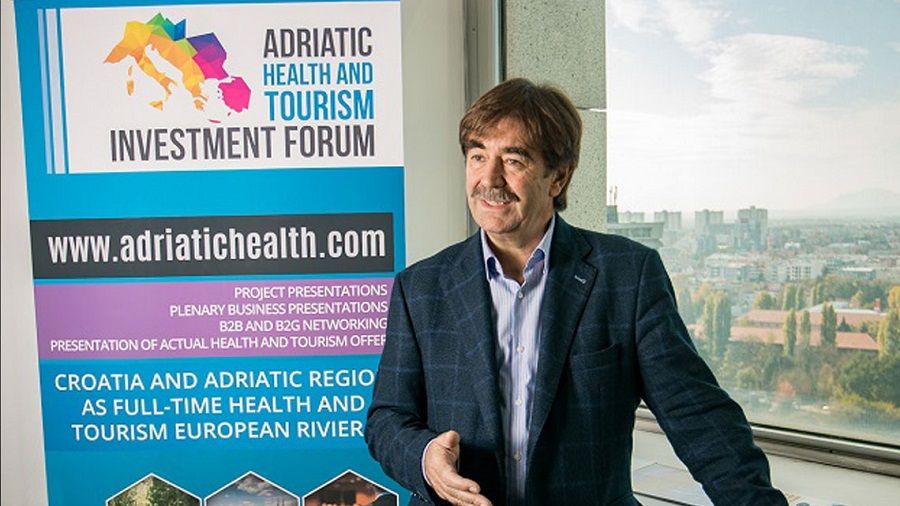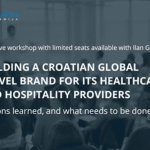The 2nd Adriatic Health Tourism Investment Forum concluded in Zagreb on October 12, 2018, an event which brought together an influential – and very international – group of medical tourism stakeholders to look at opportunities for medical tourism in Croatia and the Adriatic region. Among the high-quality speakers was Dr. Prem Jagyasi, one of the most respected speakers on the global medical tourism circuit. TCN caught up with Dr Prem to learn more about Croatia’s place on the medical tourism map, and the potential yet to be exploited.
It is just over a year since I discovered the Croatian tourism story which had eluded me for the first six years of writing about tourism in this country. A story which, once I started to delve a little deeper, made me wonder why this was not a prime focus of Croatia’s tourism strategy.
Health tourism.
Croatia as a serious player for health tourism? I can hear the skeptics, and I was also not so convinced back then. And then I did a little research, and what I found rather amazed me. I spent a little time at three clinics and found that, far from being a long way behind the West, the quality of private medical healthcare is on a par with the most developed countries. The three clinics were St Catherine’s Specialty Hospital in Zabok, favoured hospital for Croatia’s World Cup heroes, as well as a member of the Leading Hospitals of the World, offering a range of personalised medicine, including stem cell therapy; Bagatin Clinic, which has since been named as the best dermatological clinic in Europe, as well as a host of awards for its dental and cosmetic work; and Svjetlost, the leading eye clinic in the region and a highly-qualified surgical team which has performed tens of thousands of successful eye operations at a fraction of the cost. Soon after, I wrote my first article about Croatian medical tourism.
And the more I learned about the potential of Croatia’s health tourism industry, the more I was impressed – 25 things to know about health tourism in Croatia was next, an article which got quite a lot of attention in the health tourism world, including an email invitation for a meeting from one of the legends of the medical tourism world, Dr Prem Jagyasi, who said he would be speaking at the 2nd Adriatic Heath Tourism Investment Forum in Zagreb this week. I was keen to meet someone of his global standing in the medical tourism world to learn more about where Croatia sat and what could be done to improve Croatia’s health tourism industry. It turned out to be quite a chat, and – just a year after first discovering the potential of Croatia’s medical tourism industry – Dr Prem opened my eyes even wider. Croatia, it seems, is sitting on a potential goldmine, if it moves sensibly to develop an industry which could very easily become a significant percentage of the country’s GDP.
And Dr Prem was not the only international speaker of note. There was a noticeable American heavyweight presence, including the Croatian diaspora, with other speakers including former Republican presidential nominee hopeful Rick Santorum, real estate businessman Jeff Blackard, who is heavily involved int he 400 million euro Pasman marina project on the island of the same name, which will be a prime medical tourism destination in Europe once constructed.
US Ambassador to Croatia William Robert Kohorst was also present, full of praise for the quality of Croatian healthcare he and his wife had experienced, as well as committed American-Croatian cooperation to develop the industry further – watch Ambassador Kohorst’s speech above.
“There are so many aspects of medical tourism one has to consider,” Dr. Prem began, “and of course savings are a big part of that, so let’s start with that. A study was done looking at the cost of 26 common procedures in various countries. The results were interesting. For the equivalent of $685 of care in the United States, the same procedures could be done for the following prices around the world – Singapore ($205), Turkey ($175), Croatia ($185) and India ($100). So if an American needed to have $68,500 of medical care, he could get that in Croatia for $18,500. Spend $5,000 on an amazing holiday, and look at the savings. Croatia’s pricing on health tourism is competitive, and the quality of its care is high. But price is just one factor.
“A successful medical tourism destination needs to offer much more than just the operation itself, and this is where Croatia has a huge advantage to develop. It is located in Europe, within easy access of a number of countries. It is extremely safe. It has an excellent climate, nothing too extreme. It has culture and good infrastructure. English is widely spoken. It also has some great thermal spas which play a part in recuperation. And it is a fantastic tourist destination, so the possibility to combine some medical treatment with a holiday is a great combination – the savings on the treatment pay for the holiday. If you look at other places in Europe, Germany has more medical tourism than Croatia, but the conditions here are really favourable.

(Croatia, the tourist destination – the island of Hvar at night. Photo Romulic and Stojcic)
“And the industry is huge, and rising. The official number touted around is that medical tourism is about $60 billion globally, but nobody is truly tracking the numbers, and this number comes from planned medical tourism trips. In India, for example, there are so many Indians outside the country who return home and have medical procedures. If we include these numbers, the figure must be well over $100 billion a year. Croatia can get a nice piece of that.”
What can Croatia do to get more of the market?
“Croatia is a major tourism destination, with some 18 million tourists last year. Imagine that just 1% of them came and included some dental work or cosmetic surgery during that stay. That is 180,000 patients for Croatia’s medical tourism industry. And if that number rose to 2%… Croatia has all the ingredients, but it needs to work together. If you look at countries like Jordan and Turkey, they are very organised and have one central point. Turkey has a toll-free number to call for information about medical tourism, and Turkish Airlines offers a nice discount if you are flying to Turkey for medical tourism. Turkey has invested heavily in marketing. Turkey, India, Singapore are all 3-5 billion dollar businesses each year, Jordan about 1 billion. Croatia could do this and more.”

(Ref: EU Forum Competitiveness and Khaleej Times)
“As you can see from the slide above, the Croatian medical tourism industry is already on the level of quality with some of the leaders in the industry. It is becoming better known, and clinics such as Bagatin are doing a great job promoting Croatian medical tourism, as well as excellent care for their patients. They are very active at the international conferences.”
I added up the numbers on the chart above – it seemed that the conditions for medical tourism in Croatia were already above very established markets such as Turkey, Jordan, Mexico, Brazil and Thailand.
The ingredients certainly seemed to be there. Where could Croatia be in 5 years?
“Without doubt in the top 10 medical tourism countries in the world, if they get themselves properly organised.”

(Prof Miljenko Bura, organiser of the Adriatic Health and Tourism Investment Forum)
And then came the moment when I saw the true potential of medical tourism in Croatia. You have to understand that I am quite new to this kind of concept, but one of the things I was discussing with Croatia’s leading specialty hospital, St. Catherine’s, during my original research, was the relationship between private clinics and national health insurance funds. If, for example, the NHS could outsource its patients to a private clinic in somewhere like Croatia, thereby reducing waiting times and costs, it would be a win-win for all. (As I was to learn later in the day, this is already happening on a limited scale – more soon in a subsequent article on how NHS patients can get free treatment in Croatia)
“Yes, cross border healthcare. This will be huge. It has been talked about for years, and when they finally sort things out, imagine the potential for Croatia. The national health services of France, Germany, UK incentivising patients to go to places like Croatia to save money and speed up treatment. It is already happening in the United States, where insurance companies are incentivising patients to go to Latin America. Look at all the major medical tourism players from a European perspective. Croatia is in a fantastic position to take advantage, with the additional attraction of a holiday. Croatia needs to get more organised and have a central focal point, and it needs to improve its flights accessibility, but all the ingredients are there – excellent healthcare, great prices, a top tourist desination, security, a well-developed society, English spoken, located in Europe. The potential is enormous.”
To learn more about Dr. Prem, visit his official website.











